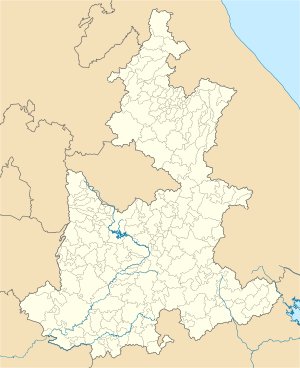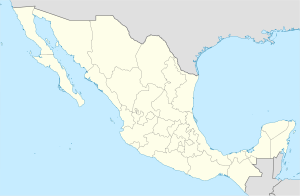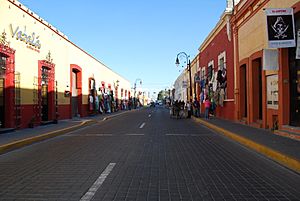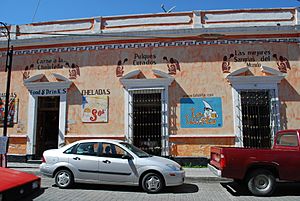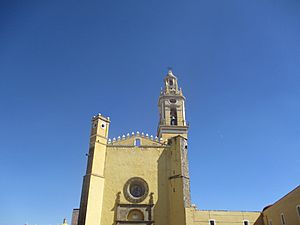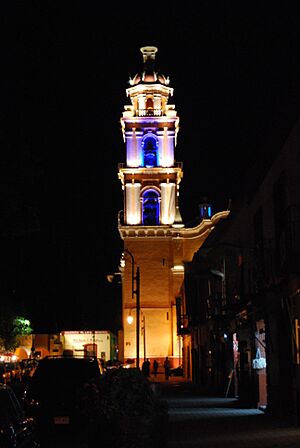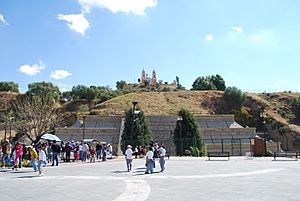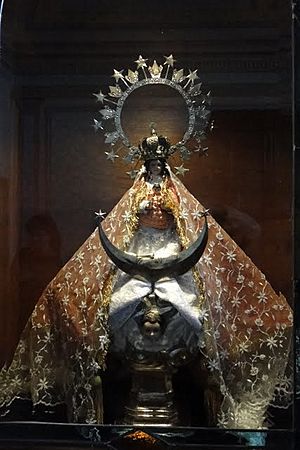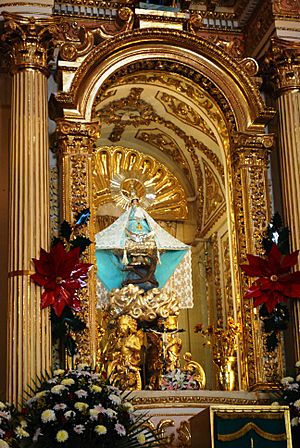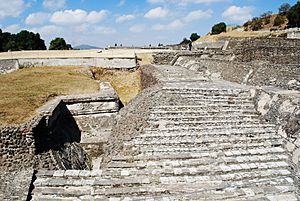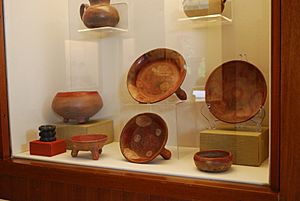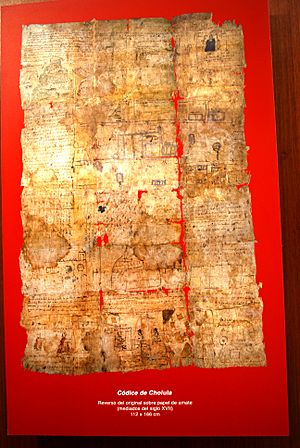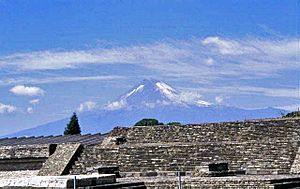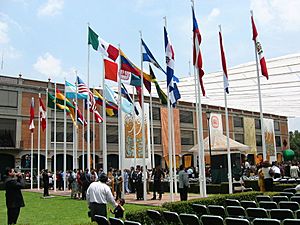Cholula, Puebla facts for kids
Quick facts for kids
Cholula
San Pedro Cholula/San Andrés Cholula
|
|
|---|---|
|
City and District
|
|
| San Pedro Cholula | |
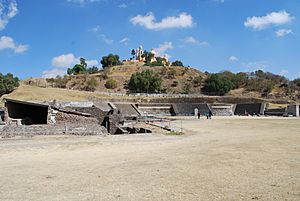
View of Pyramid and church
|
|
| Country | |
| State | Puebla |
| Founded | roughly 500 BCE |
| Municipal Status | 1860s |
| Area | |
| • Total | 111.03 km2 (42.87 sq mi) |
| Elevation
(of seat)
|
2,150 m (7,050 ft) |
| Population
(2005) San Pedro and San Andrés Municipalities
|
|
| • Total | 193,554 |
| • City | 118,170 |
| Time zone | UTC-6 (Central (US Central)) |
| Postal code (of seat) |
72810
|
| Area code(s) | 222 |
| Demonym | Choluteco |
| Website | San Andrés and SanPedro |
Cholula is an ancient city in Mexico, located near the city of Puebla. It's famous for its huge Great Pyramid, which has a church called the Iglesia de Nuestra Señora de los Remedios built right on top of it. Cholula is also known for having many, many churches!
The city of Cholula is split into two main parts: San Pedro Cholula and San Andrés Cholula. Around the city, there are also smaller, more rural communities. The city itself is divided into eighteen neighborhoods, or barrios, each with its own special patron saint.
This way of dividing the city has been around since before the Spanish arrived. The city stays connected through a system of shared religious duties, called cargas. These duties help support a calendar full of saints' days and festivals that happen almost all year long. The biggest festival celebrates the Virgin of the Remedies, who is the patron saint of the entire city. This happens in early September. Cholula is one of the oldest cities in the world where people have lived continuously. It's even the oldest continuously inhabited city in the Americas!
Contents
Exploring Cholula: Landmarks and Culture
What Makes Cholula Special?

Cholula is located just west of Puebla, the state capital. It's part of Puebla's larger metropolitan area. The city is divided into two municipalities: San Pedro Cholula and San Andrés Cholula. These also include smaller towns around the main city. The main town square is in San Pedro Cholula. But the Great Pyramid, which is only a few blocks away, is in San Andrés Cholula. San Andrés is more residential and has more people from indigenous groups. The whole city is officially called the Distrito Cholula de Rivadavia. This name was given in 1895 to honor Bernardino Rivadavia.
Since the early colonial period, Cholula has been organized into eighteen neighborhoods. Before the Spanish arrived, the city had official neighborhoods called capullis. The Spanish then reorganized these around churches, each with a patron saint. Eight of these neighborhoods are in San Andrés, and ten are in San Pedro. Many neighborhood names combine a saint's name with an old indigenous (Nahuatl) name. The neighborhoods closer to the city center are more urban. Those on the edges still feel more rural, with farming and brick-making as main jobs.
The Heart of the City: Main Square and Buildings
Cholula is on the flat plains of the Valley of Puebla. You can see the Popocatépetl and Iztaccíhuatl volcanoes to the west. Like Puebla, the city has straight streets that run north, east, south, and west. The main square is called the Plaza de la Concordia, or sometimes the Zocalo. In the mornings, you'll find vendors selling street food, sweets, and handmade toys here.
On the west side of the plaza is the city hall. This building was built over the old Xiuhcalli, where noble councils met long ago. In front of the city hall, there's a long covered walkway called the portales. It's about 170 meters (558 feet) long with 46 arches. This arcade is the longest of its kind in Latin America.
On the east side of the main plaza is the 16th-century San Gabriel friary. It has a very large open area, a Royal Chapel, and a tall main church. Franciscan friars still live in its cloister. On the north side, there's the Parish of San Pedro, built in the 17th century. One of the oldest homes in Cholula, the Casa del Caballero Aguilar, is now the Museo de la Ciudad de Cholula (Cholula City Museum). This museum opened in 2001 and shows the history of Cholula from about 1000 BCE. It has pre-Hispanic artifacts and items from the colonial period, including religious art.
Fun and Exploration in Cholula
Because of the Universidad de las Americas Puebla students and many tourists, Cholula has a lively nightlife with clubs and bars, especially near the main plaza. However, it's quieter during the week when these places are closed.
Since the modern city is built over an ancient metropolis, a large area is an archeological site. Only a small part of this area has been explored because most of the land is privately owned.
Unique Places to Visit
- La Quinta Luna is a 17th-century house that's now a boutique hotel. It was once the home of a local noble. The hotel has seven luxury rooms, a library with about 3,000 books, and a restaurant in what used to be the chapel.
- Container City is a cool complex made from large shipping containers. Fifty containers have been painted brightly and joined together to create spaces for workshops, restaurants, and shops. It even has wireless internet and entertainment areas.
- Parque Loro is a petting zoo with over 400 animals, including endangered species like monkeys, tigers, and jaguars. It has animal shows and a playground.
Traditional Markets and Local Food
Cholula has many traditional Mexican markets. The biggest is the Mercado Municipal. Here, you can see women selling seeds, flowers, and herbs on the floor, just like in old times. On Wednesdays and Sundays, the market gets even bigger with street vendors. This is called a tianguis. People from nearby communities come to buy and sell local products like flowers, fruits, and vegetables.
You can also find food stands serving local dishes. Some Cholula specialties include:
- Cholulteca soup
- Cecina (thinly sliced dried meat) with chili pepper strips and queso de canasta (a type of cheese)
- Cueclas (a type of edible larvae)
- Tacos placeros (tacos with cecina, Bolivian coriander (pápalo), avocado, cheese, and green chili strips)
- Orejas de elefante ('elephant ears'), which are huge tortillas with beans inside and salsa, tomatoes, and cheese on top.
For drinks, try "Copa de Oro," a local hard apple cider. There's also a cold chocolate and water drink, whipped until foamy and served in wooden bowls. Another drink is ponche, made with blue corn and milk.
Mysterious Houses
In San Luis Tehuiloyocan, just outside the city, there's a 17th-century house with strange mosaics. The inner courtyard walls have volcanic stone mosaics showing animals like a goat and a rabbit, flames, and Christian symbols. The main doorway is framed by two dancing monkeys with bishops' hats. Some people believe the house was used for unusual rites in the 18th century because of its unique imagery.
The Antigua Casa del Gobernador (Old Governor's House) was built around 1714. This building was where the local council met and where elections for the governor took place. Today, it's used for many different community events.
Churches of Cholula
People often say Cholula has 365 churches, one for each day of the year, or one for each ancient temple that used to be there. In reality, there are about 37 churches, or 159 if you count all the small chapels on local farms.
The churches in Cholula show many different architectural styles, like Gothic, Renaissance, and Neoclassical. Many mix different styles. Some are decorated with colorful Talavera tiles, which are common in Puebla. Others have beautiful stucco work done by indigenous artists. These churches hold over 300 valuable artworks from the 16th to 19th centuries. Because of art theft, many churches are now closed during the week or have guards and video cameras. Some even display replicas of their artworks.
Many church steeples in the city were damaged during the 2017 Puebla earthquake.
Most of Cholula's churches were built between the 17th and 19th centuries. Many are parish churches for the city's neighborhoods. The Parish of San Pedro is the main church for the San Pedro municipality. It was built in the 17th century and faces the city's main square. Its style mixes Baroque and Renaissance elements.
The parish church of the San Andrés municipality was started in the early 16th century. Its main front has a large image of the Apostle Andrew crucified on an X. Inside, there's a chapel dedicated to the Virgin of Solitude with a highly decorated altar.
Two other important churches are the Iglesia de Nuestra Señora de los Remedios and the Church of San Francisco Acatepec. The Nuestra Señora de los Remedios church is the most famous because it sits on top of the Great Pyramid. This church was built in 1594 and houses an image of the Virgin of the Remedies, the patron saint of Cholula. The first church was destroyed by an earthquake in 1854 and rebuilt. It was damaged again in 1999 but repaired. The pyramid was a pilgrimage site long ago, and it still is today for people visiting this Virgin.
The Church of Santa María Tonantzintla is also very important in San Andrés. It's known for its unique "folk" or indigenous Baroque decoration.
The Great Pyramid and Our Lady of Remedies Church
The biggest attraction in Cholula is the Great Pyramid with the Nuestra Señora de los Remedios church on top. At first glance, the pyramid looks like a natural hill because it's mostly covered in plants. The south side of the pyramid has been excavated, revealing a network of tunnels inside. About 220,000 people visit the pyramid and church each year. On special days, like the spring equinox or the feast of the Virgin of the Remedies, up to 20,000 visitors might come at once. From the church's courtyard at the top, you can see the Malinche, Popocatepetl, Iztaccíhuatl, and Pico de Orizaba volcanoes in the distance.
The Great Pyramid of Cholula
Legend says a giant named Xelhua built the pyramid from adobe bricks. Building the pyramid started in the Pre-Classic period. Over time, it was built over six times, growing to its final size of 120 meters (394 feet) on each side at the base and 18 meters (59 feet) tall. Its base is four times larger than the Great Pyramid of Giza in Egypt, making it the largest pyramid base in the Americas! Some parts of the pyramid use a building style called talud-tablero, similar to what was used in Teotihuacan.
The pyramid has been overgrown for centuries. By the time the Spanish arrived, it looked like a hill. Only the church built in the 16th century was clearly visible on top.
Exploration of the pyramid began in 1931. Archeologists dug about 8 kilometers (5 miles) of tunnels inside to study its different layers. Today, about 800 meters (2,625 feet) of these tunnels are open to the public. You can see parts of the main staircases of older pyramids inside. There are also two famous murals: "Chapulines," showing grasshoppers, and "Bebedores," showing people drinking pulque (an alcoholic drink).
The Cholula Pyramid site museum is across the street from the pyramid. It's a small museum with two rooms. One room has a model showing the pyramid's different construction stages. The second room displays artifacts found in the area, like clay figures and pots. It also has copies of the two main murals.
On the spring and fall equinoxes, a special Quetzalcoatl ritual is performed at the pyramid. It includes poetry, indigenous dance, music, and fireworks. To protect the site, authorities have bought land around the pyramid and turned it into soccer fields and flower gardens.
The Nuestra Señora de los Remedios Church
The pyramid was a sacred place for pilgrims long ago, and it still is today. People come to visit an image of the Virgin of the Remedies, especially in September. This Virgin Mary image is particularly dedicated to helping the poor. Her story in Mexico dates back to the Spanish Conquest. Many stories say she was brought by a Spanish soldier named Juan Rodríguez de Villafuerte. She was seen as a protector of the conquistadors.
The sanctuary for this Virgin was built in 1594. The church has been damaged several times by lightning and earthquakes. In 1864, an earthquake almost completely destroyed it, and it took ten years to rebuild. Another earthquake in 1999 damaged the church again, but the image of the Virgin was safe.
After climbing the pyramid, there are 48 steps leading up to the church's courtyard. From here, you get amazing views of the Popocatepetl and Iztaccíhuatl volcanoes and the many church domes in the city. The church's exterior is simple, but its dome is covered in colorful tiles from Puebla.
The inside of the church is in the Baroque style with some Neoclassical elements. It has oil paintings, sculptures, and altars made of wood and plaster, painted white and decorated with gold leaf. The dome has allegorical paintings and images of important Catholic figures.
Neighborhoods and Lively Festivals
Cholula is made up of two municipalities: San Pedro Cholula and San Andrés Cholula. But the most important social division is its neighborhoods, or barrios. San Pedro has eight neighborhoods, and San Andrés has ten. In ancient times, the city had different ethnic groups. They were united by their religious beliefs. After the Spanish arrived, they reorganized these neighborhoods around different patron saints. These neighborhoods still exist today, often named after their saint followed by their original indigenous name.
Even after five centuries, people in Cholula still follow many traditional practices. These often have roots in ancient times. One important tradition is a ten-year cycle called the "circular," where different neighborhoods take turns with citywide religious duties.
Religious festivals happen almost all year round in Cholula. Social life in the neighborhoods revolves around these events. People and entire neighborhoods take turns with religious and ceremonial duties, called cargas. Many of these are for neighborhood patron saints. These festivals require a lot of work, money, and organization. For example, during big festivals, the San Andres church is beautifully decorated with flowers. There are also sand paintings on the ground with designs from the Bible.
Cargas usually last for one year. They can start small, like cleaning the neighborhood church. But most involve sponsoring the many religious festivals in the city. This system is one of the most complex of its kind in the world. Taking on a carga gives a person, called a mayordomo, respect from the community because they are seen as working for the common good. Mayordomos can be men, women, or even children. The most respected carga is being the mayordomo for the neighborhood's patron saint. Even more important is being a mayordomo for a citywide festival, like the festival of the Virgin of the Remedies.
Important Festivals in Cholula
The most important festival time in Cholula is from August 31 to mid-September. It centers around the city's patron saint, the Virgin of the Remedies.
- The Procession of the Lamps (Procesión de los Faroles) happens on the night of August 31. Neighborhoods carry images of their patron saints in a procession through the streets. It ends at the Nuestra Señora de los Remedios church on the pyramid with Mass and singing.
- The Feast of the Virgin of the Remedies officially begins on September 1 and lasts about a week. The main day is September 8, celebrating the Virgin's appearance in the city. Events include indigenous dances and pilgrims bringing offerings. In the afternoon, there's a burning of panzones, which are large paper figures filled with fireworks.
- After honoring the Virgin, people gather in Concordia Plaza for the "trueque" (trade). This is an ancient tradition where people exchange and sell goods. You can find local cheeses, herbs, wood, incense, nuts, fruits, and crafts like mats and baskets. The trueque has also grown into a regional fair called the Feria de Cholula, with local food and music.
- The Bajada de la Virgen is another important event involving the Virgin of the Remedies. Instead of people climbing the pyramid, the Virgin's image comes down for two weeks in May or June to visit different neighborhoods. This tradition started in 1825. Today, a replica image is used because the original is very old. These replicas are called "sisters" to the original. During the Bajada, the image is carried through streets decorated with elaborate flower gateways.
- Like other cities in the area, Cholula celebrates Carnival. This tradition started over 90 years ago, with events focused on the main square. The main dancers are called Huehues, meaning "ancient ones." Over 3,000 dancers from different neighborhoods and nearby states participate.
- The Quetzalcóatl Ritual is celebrated on the spring equinox. It includes indigenous dancing and greeting the sun at the Patio of the Altars.
- Concierto para Campanas (Bell Concert), also called the Vaniloquio, is an event where most of the city's 37 churches ring their bells together to special music. This happens on November 28 and the Sunday after Ash Wednesday. Over 150 bells are rung by 130 people.
- There are many events during Lent and Holy Week. The Tlahuanca is held on the fourth Monday of Lent, where wooden crosses are given out. For the death of the Virgin Mary, colorful sawdust carpets are made on the ground. This is also done before Good Friday for the Stations of the Cross procession. The Altepeilhuitl happens on the Sunday before Christ's ascension. Images of patron saints are decorated with fruits and vegetables.
- In May, there's the Fiesta de Pobres and Labradores ('Festival of the Poor and Laborers'), also known as the Feast of the Holy Trinity. It lasts about a month and includes merchants, woodworkers, and farmers. Another event for common people is the festival of Isidore the Laborer, where farm workers parade with their decorated machines.
- Cholula also has fairs for local products. The Nopal Cactus Fair (Feria del Nopal) celebrates the main crop in San Bernardino Tlaxcalanzingo in early June. The Cheese Fair (Feria del Queso) is held in Santa Maria Tonantzintla in early August. There's also an annual bread festival where an enormous brick oven is built in the main plaza, and local bakers show traditional techniques.
Between these big events, there are many patron saint days for all the neighborhoods. These often include amusement rides, fireworks, dancing, and sometimes a "visit" from one of the Virgin of the Remedies images.
Cholula's Rich History
Ancient Cholula: A Powerful City
The name Cholula comes from the Nahuatl word Cholōllān. It might mean "where water falls" or "place of those who fled." "Place of those who fled" refers to a myth about Toltec refugees coming here after their city, Tula, fell around 1000 CE. One Aztec myth says the people of Cholula, called Chololtecs, came from one of the seven Aztec tribes that migrated to central Mexico.
Cholula began as two small villages between 500 and 200 BCE. These were farming villages with ceremonial centers. Cholula grew as other settlements were abandoned, becoming the main power in the region. This is when work on the Great Pyramid began. Cholula continued to grow during the Classic period (200–800 CE), reaching a population of 20,000 to 25,000 people. It remained dominant in the Puebla-Tlaxcala region, adding more stages to the Great Pyramid.
During this time, Cholula was influenced by the larger city of Teotihuacan. Pottery styles were similar, but living spaces were different. When Teotihuacan declined, Cholula's population also dropped.
In the 12th century, Nahua people migrated to the Valley of Puebla. They eventually became the ruling class in Cholula. The new leaders, called Chololtecs, shifted their religious focus away from the Great Pyramid to a new temple for Quetzalcoatl. Some parts of the pyramid were even destroyed during this change.
In the Post-classic period (900–1521), Cholula grew to its largest size and became a powerful city again. Its location was perfect for trade between the Valley of Mexico, the Valley of Oaxaca, and the Gulf of Mexico. This made it a major trading center. An artistic style, especially in pottery, called Mixteca-Puebla, spread from Cholula through its vast trading networks. The city was divided into three areas by the late pre-Hispanic period: San Pedro Cholula, San Andrés Cholula, and San Isabel Cholula. Only the first two are part of the city today.
Colonial Period: Spanish Arrival and Changes
When the Spanish arrived, Cholula was a major religious and trading center. The Quetzalcoatl Temple was one of the most important pilgrimage sites. Hernán Cortés estimated the city had 430 temples and about 20,000 homes.
Cortés arrived in Cholula after defeating the Tlaxcalans. He was supposed to meet Moctezuma II here. Since Cholula was allied with the Aztecs, the Spanish and Tlaxcalans were suspicious. Spanish accounts say Cortés was warned of a plot to attack them. Cortés then gathered the city leaders in the main square. On a signal, the Spanish attacked and killed many Chololtecs. This event is called the Cholula Massacre. It resulted in many deaths and much destruction.
Unlike many other ancient cities, Cholula survived the Conquest. But the Spanish built the city of Puebla nearby, which quickly became more important. This, along with an epidemic that killed many indigenous people, meant Cholula never regained its former power. The area was first divided into encomiendas (land grants). In 1531, the entire city came under the direct control of the Spanish Crown.
Cholula became an official city in 1535 and received its coat of arms in 1540. Over the colonial period, 47 churches were built. In 1714, the San Andrés part of the city, where most indigenous people lived, gained limited self-rule as an "Indian republic."
From Independence to Today
San Pedro and San Andrés became two separate municipalities in the 1860s. In 1895, the city that spans both was named the Distrito Cholula de Rivadavia, honoring Bernardino Rivadavia.
Economy and Tourism in Cholula
Cholula's main economic activities are trade and agriculture, though farming is becoming less dominant. Trade, including tourism, is mostly in the city center. Farming and industries like brick making are found on the city's edges and in the rural areas of San Pedro and San Andrés. Cholula is part of the Puebla metropolitan area, so residential areas are growing into former farmlands.
Most of San Pedro municipality is used for agriculture, especially irrigated farms. Farming employs about 30% of the population in San Andrés and 17.4% in San Pedro. Important crops include corn, beans, nopal cactus, onions, and various fruits. There's also a lot of flower growing. Livestock includes cattle, goats, and pigs.
Industry and construction employ about 39% of the population in San Pedro and 30% in San Andrés. Industries in San Pedro include making bricks, textiles, and ceramics. In San Andrés, industries focus on cheese, furniture, and ironwork. The whole area also makes hard apple cider.
Trade, services, and tourism employ about 39% of the population in San Pedro and 35% in San Andrés. Tourism is based on the city's history. The main attractions are the Great Pyramid with the Nuestra Señora de los Remedios church on top, the San Gabriel friary, and the many colorful churches. Pictures of the church on the pyramid with Popocateptl in the background are often used to promote tourism in Mexico. Cholula is a well-known destination for travelers in central Mexico.
Geography of Cholula
Cholula is in the central-west part of Puebla state, in the Valley of Puebla. It's about 122 kilometers (76 miles) east of Mexico City and 8 kilometers (5 miles) west of Puebla. This valley is surrounded by mountains and volcanoes. The Cholula area covers about 111.03 square kilometers (42.87 sq mi), divided between San Andrés (61 km2) and San Pedro (51.02 km2).
The geography of Cholula is mostly flat, with an average height of 2,100 to 2,200 meters (6,890 to 7,218 feet) above sea level. The Atoyac River flows through the area. The Zapotecas mountain (2,377 meters / 7,799 feet) is the main high point, about 3 kilometers (2 miles) west of the main square. The Zapotecas mountain is popular for mountain biking and off-road motorcycles. There's also a parasailing school in San Andrés.
Climate and Nature
Cholula has a temperate subtropical highland climate, typical for central Mexico. The average temperature is between 18 and 20 °C (64 and 68 °F). January is the coldest month, and May is the warmest. The rainy season lasts from May to October, bringing about 800 to 900 mm (31 to 35 inches) of rain each year. These conditions made the area great for farming since ancient times.
The only forested area is part of the Sierra del Tentzo, with oak forests. The rest of the area is either farmland or covered by human settlements.
People and Education
Population of Cholula
In 2005, the city of Cholula had a population of 118,170 people. This includes 35,206 in San Andrés and 82,964 in San Pedro. The total population for both municipalities, including rural areas, is 193,554. Most people in Cholula are Catholic. While most of the population is mestizo (mixed heritage), there are many indigenous families, especially in San Andrés.
Schools and Universities
The Cholula area has many schools: preschools, primary schools, middle schools, high schools, and technical schools. It is also home to a major university, the private Universidad de las Américas Puebla (UDLAP). UDLAP's programs are similar to those at Oxford and Harvard.
UDLAP offers bachelor's, master's, and doctorate degrees in many subjects. Its campus was built in 1970 with beautiful gardens. Students and locals can watch the school's basketball and American football teams, the Aztecas, play at the Estadio Templo de Dolor. Cultural events happen at the main auditorium, which also hosts a film club. There are two art galleries, Sala José Cuevas and Sala Bertha Cuevas, which have temporary exhibits. The Instituto Garcia de Cisneros, a Catholic school run by Franciscan friars, is also a large school facing the town square.
Getting Around Cholula
The city has an intercity bus station run by Estrella Roja. There are also local buses between Cholula and Puebla run by Super Rápidos. For shorter trips, you can find "colectivos" (shared taxis or mini vans) that connect to nearby places.
See also
 In Spanish: Cholula de Rivadavia para niños
In Spanish: Cholula de Rivadavia para niños


